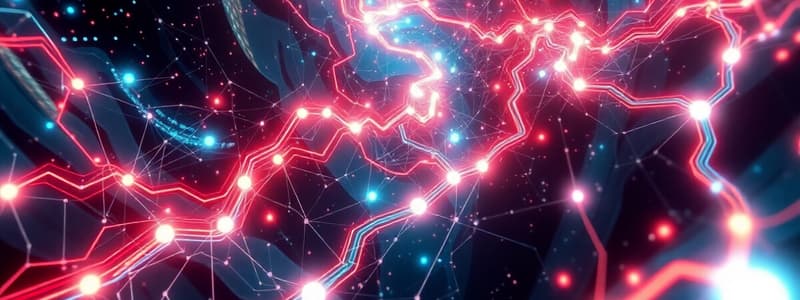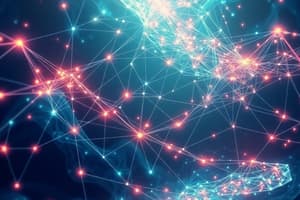Podcast
Questions and Answers
In what century did Islam originate?
In what century did Islam originate?
- 9th century
- 6th century
- 7th century (correct)
- 8th century
The Seljuks were Christians.
The Seljuks were Christians.
False (B)
What city is considered holy by Jews, Christians, and Muslims?
What city is considered holy by Jews, Christians, and Muslims?
Jerusalem
Pope Urban II organised a council in the city of ________.
Pope Urban II organised a council in the city of ________.
In what year did Pope Urban II organize a council in Clermont?
In what year did Pope Urban II organize a council in Clermont?
Pope Urban II asked Christians to fight and stop the threat posed by the Muslims.
Pope Urban II asked Christians to fight and stop the threat posed by the Muslims.
Who called for the Crusades in 1095?
Who called for the Crusades in 1095?
The pope wanted to recover ________ from Muslim rule.
The pope wanted to recover ________ from Muslim rule.
Which group defeated the Christian Byzantines?
Which group defeated the Christian Byzantines?
The Byzantines did not ask Pope Urban II for help.
The Byzantines did not ask Pope Urban II for help.
What was the name of the Muslim group that conquered large parts of the Middle East?
What was the name of the Muslim group that conquered large parts of the Middle East?
The pope believed that uniting Christian kings would bring ________ back to Europe.
The pope believed that uniting Christian kings would bring ________ back to Europe.
What spurred Pope Urban II to call for the Crusades?
What spurred Pope Urban II to call for the Crusades?
The Crusades were solely motivated by religious reasons.
The Crusades were solely motivated by religious reasons.
What was a primary goal of the Crusades?
What was a primary goal of the Crusades?
The Crusades were aimed at stopping the threat posed by the ________.
The Crusades were aimed at stopping the threat posed by the ________.
What was the name given to the series of wars fought by Christians to reclaim the Holy Land?
What was the name given to the series of wars fought by Christians to reclaim the Holy Land?
The Crusades had no economic or cultural effects.
The Crusades had no economic or cultural effects.
Which group was known for plundering towns and villages during the First Crusade?
Which group was known for plundering towns and villages during the First Crusade?
The streets of Jerusalem were filled with ________ after the crusaders breached the city's defenses.
The streets of Jerusalem were filled with ________ after the crusaders breached the city's defenses.
What event is known as the 'Rhineland Massacres'?
What event is known as the 'Rhineland Massacres'?
Jews were seen as enemies during the Crusades.
Jews were seen as enemies during the Crusades.
In what year were Jews completely expelled from England during the crusades?
In what year were Jews completely expelled from England during the crusades?
Many people joined the Crusades searching for ________ or treasure.
Many people joined the Crusades searching for ________ or treasure.
How many crusades took place in total?
How many crusades took place in total?
Jerusalem remained in Christian hands for a long time after the Crusades.
Jerusalem remained in Christian hands for a long time after the Crusades.
What split occurred in 1054 between the churches?
What split occurred in 1054 between the churches?
The ________ Empire did not become Christian.
The ________ Empire did not become Christian.
Which Italian cities became wealthy from shipping crusaders?
Which Italian cities became wealthy from shipping crusaders?
Arab traders made great losses during the Crusades.
Arab traders made great losses during the Crusades.
From whom did Europeans preserve knowledge during the Crusades?
From whom did Europeans preserve knowledge during the Crusades?
The Crusades ushered in a new era for Europeans, the ________.
The Crusades ushered in a new era for Europeans, the ________.
What was the main motivation for Europeans to launch attacks during the Crusades from the Muslim perspective?
What was the main motivation for Europeans to launch attacks during the Crusades from the Muslim perspective?
King Richard the Lionheart and Saladin were enemies without any mutual respect.
King Richard the Lionheart and Saladin were enemies without any mutual respect.
Who sent his personal doctor when Richard fell ill?
Who sent his personal doctor when Richard fell ill?
Europeans learned about medical practices, astrology, and Arabic ________ through contact with Arabs.
Europeans learned about medical practices, astrology, and Arabic ________ through contact with Arabs.
In the 13th century, many young adults went off to reclaim what land?
In the 13th century, many young adults went off to reclaim what land?
The Children’s Crusade was successful in reclaiming the Holy Land.
The Children’s Crusade was successful in reclaiming the Holy Land.
What happened to those that didn't die in the Children's Crusade?
What happened to those that didn't die in the Children's Crusade?
During the First Crusade, an eyewitness thought that a bird gave directions to the ________.
During the First Crusade, an eyewitness thought that a bird gave directions to the ________.
Which of these was a primary reason Pope Urban II called for the Crusades?
Which of these was a primary reason Pope Urban II called for the Crusades?
The Crusades resulted in a lasting Christian control over Jerusalem.
The Crusades resulted in a lasting Christian control over Jerusalem.
What was the name of the Muslim tribe that conquered large parts of the Middle East in the 11th century?
What was the name of the Muslim tribe that conquered large parts of the Middle East in the 11th century?
The Crusades involved clashes not just between Christians and Muslims, but also against communities such as the ______.
The Crusades involved clashes not just between Christians and Muslims, but also against communities such as the ______.
Match the following effects with the Crusades:
Match the following effects with the Crusades:
Flashcards
Rise of Islam
Rise of Islam
Islam, founded in the 7th century by Muhammad, rapidly spread through the Middle East, Asia, North Africa, and Europe.
Seljuks
Seljuks
A Turkish Muslim tribe that conquered large parts of the Middle East and came into conflict with the Byzantine Empire around 1050.
Byzantine Appeal
Byzantine Appeal
After the Seljuks humiliated and imprisoned the Byzantine emperor, the Byzantines felt their authority was threatened and requested help from Pope Urban II.
Pope Urban II's Response
Pope Urban II's Response
Signup and view all the flashcards
Call to Crusade
Call to Crusade
Signup and view all the flashcards
Jerusalem
Jerusalem
Signup and view all the flashcards
Who joined the First Crusade?
Who joined the First Crusade?
Signup and view all the flashcards
Arrival at Jerusalem
Arrival at Jerusalem
Signup and view all the flashcards
Massacre in Jerusalem
Massacre in Jerusalem
Signup and view all the flashcards
Crusades against the Jews
Crusades against the Jews
Signup and view all the flashcards
Rhineland Massacres
Rhineland Massacres
Signup and view all the flashcards
Jewish Persecution
Jewish Persecution
Signup and view all the flashcards
Crusades failure
Crusades failure
Signup and view all the flashcards
Crusades effect on the Churches
Crusades effect on the Churches
Signup and view all the flashcards
Economic effects of the Crusades
Economic effects of the Crusades
Signup and view all the flashcards
Europeans' Benefit
Europeans' Benefit
Signup and view all the flashcards
Pope Urban II's aims
Pope Urban II's aims
Signup and view all the flashcards
Crusaders action
Crusaders action
Signup and view all the flashcards
Effects of Crusades
Effects of Crusades
Signup and view all the flashcards
Study Notes
Ford-Fulkerson Algorithm
- A greedy algorithm used to compute the maximum flow in a flow network.
- Input: Flow network $G=(V, E)$ with capacities $c(u, v) \geq 0$ for all $(u, v) \in E$.
- Output: Maximum flow $f$ from $s$ to $t$.
- Initial flow $f(u, v) = 0$ for all $(u, v) \in E$.
- The algorithm iterates as long as there exists an augmenting path $p$ from $s$ to $t$ in the residual network $G_f$.
- Rest capacity $c_f(p) = \min{c_f(u, v) | (u, v) \in p}$ is computed.
- The flow along path $p$ is augmented by $c_f(p)$.
- For each edge $(u, v) \in p$:
- $f(u, v) = f(u, v) + c_f(p)$
- $f(v, u) = f(v, u) - c_f(p)$
- For each edge $(u, v) \in p$:
- Finally, the maximum flow f is returned.
Residual Network
- Denoted as $G_f$, with the same nodes as $G$.
- Edges represent residual capacity.
- The residual capacity of an edge $(u, v)$ is defined as $c_f(u, v) = c(u, v) - f(u, v)$, if $f(u, v) > 0$, and $c_f(v, u) = f(v, u)$, if $f(u, v) < 0$.
Augmenting Path
- A path from $s$ to $t$ in the residual network $G_f$.
- It possesses positive residual capacity.
Example
- Flow network with nodes $s, a, b, t$ and edges $(s, a), (s, b), (a, b), (a, t), (b, t)$.
- Capacities are $c(s, a) = 10, c(s, b) = 5, c(a, b) = 4, c(a, t) = 8, c(b, t) = 10$.
- The maximum flow found is 13.
Analysis
- Runtime depends on the choice of augmenting paths.
- Exponential time can be required if capacities are irrational (worst case).
- With integer capacities, the runtime is $O(E \cdot f^)$, where $f^$ is the value of the maximum flow.
- The Edmonds-Karp algorithm uses breadth-first search to find augmenting paths, with a runtime of $O(V \cdot E^2)$.
Matrix Basics
Definition
- An $m \times n$ matrix is a rectangular array of $m \cdot n$ real or complex numbers
- Denoted as $A = (a_{ij})$, $A_{m \times n}$.
- $a_{ij}$ is an element of the matrix at the $i$th row and $j$th column
- $i$ is the row index, $j$ is the column index
- $m$ is the number of rows, $n$ is the number of columns
- Type of a matrix is $m \times n$
Examples
- $A = \begin{bmatrix} 1 & 2 \ 3 & 4 \end{bmatrix}_{2 \times 2}$
- $B = \begin{bmatrix} 1 & 2 & 3 \end{bmatrix}_{1 \times 3}$
- $C = \begin{bmatrix} 1 \ 2 \ 3 \end{bmatrix}_{3 \times 1}$
Terminology
- A square matrix is a matrix where $m = n$
- The elements $a_{11}, a_{22}, \dots, a_{nn}$ form the main diagonal if $m = n$
- An upper triangular matrix is a square matrix where $a_{ij} = 0$ when $i > j$
- A lower triangular matrix is a square matrix where $a_{ij} = 0$ when $i < j$
- A diagonal matrix is a square matrix where $a_{ij} = 0$ when $i \neq j$, denoted as $A = diag(a_{11}, a_{22}, \dots, a_{nn})$
- An identity matrix is $I = diag(1, 1, \dots, 1)$
- A zero matrix is $A = (a_{ij})$ where $a_{ij} = 0$ for all $i, j$
- A row vector is a $1 \times n$ matrix
- A column vector is an $m \times 1$ matrix
Matrix Operations
- For $A = (a_{ij})$ and $B = (b_{ij})$ of the same type $m \times n$, and scalar $c$:
- Matrix addition: $A + B = (a_{ij} + b_{ij})$
- Scalar multiplication: $cA = (ca_{ij})$
- For matrix $A_{m \times n}$ and $B_{n \times p}$, the product $AB = C_{m \times p}$ is defined as:
- Each element $c_{ij} = \sum_{k=1}^{n} a_{ik}b_{kj}$
- Note*: Matrix multiplication is not commutative, meaning $AB \neq BA$ in general.
Examples
- $\begin{bmatrix} 1 & 2 \ 3 & 4 \end{bmatrix} + \begin{bmatrix} 5 & 6 \ 7 & 8 \end{bmatrix} = \begin{bmatrix} 6 & 8 \ 10 & 12 \end{bmatrix}$
- $2 \begin{bmatrix} 1 & 2 \ 3 & 4 \end{bmatrix} = \begin{bmatrix} 2 & 4 \ 6 & 8 \end{bmatrix}$
- $\begin{bmatrix} 1 & 2 \ 3 & 4 \end{bmatrix} \begin{bmatrix} 5 & 6 \ 7 & 8 \end{bmatrix} = \begin{bmatrix} 19 & 22 \ 43 & 50 \end{bmatrix}$
Regular Expressions (Regex)
Definition
- A regular expression (Regex) is a sequence of characters that define a search pattern.
Applications
- Text searching.
- Text replacement.
- Input format validation.
Components
Character Classes
\d: Digit (0-9).\w: "Word character" (A-Z, a-z, 0-9, _).\s: Whitespace (space, tab, newline)..: Any character (except newline).
Quantifiers
*: Zero or more occurrences.+: One or more occurrences.?: Zero or one occurrence.{n}: Exactly n occurrences.{n,}: n or more occurrences.{n,m}: Between n and m occurrences.
Anchors
^: Beginning of the line.$: End of the line.\b: Word boundary.
Grouping and Alternation
(): Grouping.|: Alternation ("or").
Examples
\d{3}-\d{2}-\d{4}: Pattern for a date in the format "XXX-XX-XXXX".[a-zA-Z]+: One or more letters (uppercase or lowercase).^Hello\sWorld$: A line that contains exactly "Hello World".
Using in Python
Module re
- The
remodule provides functions for working with regular expressions.
Important Functions
re.search(pattern, string): Searches for the first occurrence of the pattern in the string.- Returns a match object if found, otherwise
None.
- Returns a match object if found, otherwise
re.match(pattern, string): Checks if the pattern matches the beginning of the string.re.findall(pattern, string): Finds all non-overlapping occurrences of the pattern.- Returns a list of strings.
re.sub(pattern, replacement, string): Replaces all occurrences by replacement.re.compile(pattern): Compiles a regular expression into a regex object.- More efficient when using the same pattern repeatedly.
Example
import re
text = "Meine Telefonnummer ist 012-3456-7890."
pattern = r"\d{3}-\d{4}-\d{4}" #Raw string
match = re.search(pattern, text)
if match:
print("Telefonnummer gefunden:", match.group())
Tips
- Use raw strings (
r"...") to avoid escaping backslashes. - Use online tools for testing regular expressions.
- Keep regular expressions simple and clear.
Chemical Kinetics
Reaction Rate
- For the reaction $aA + bB \rightarrow cC + dD$, the rate is:
- $Rate = -\frac{1}{a}\frac{d[A]}{dt} = -\frac{1}{b}\frac{d[B]}{dt} = \frac{1}{c}\frac{d[C]}{dt} = \frac{1}{d}\frac{d[D]}{dt}$
- $[A]$ = concentration of reactant A
- $\frac{d[A]}{dt}$ = rate of change of concentration of A with time
Rate Law
- $Rate = k[A]^x[B]^y$
- $k$ = rate constant
- $x$ = order of reaction with respect to A
- $y$ = order of reaction with respect to B
- $x + y$ = overall order of reaction
- Values of $x$ and $y$ are determined experimentally.
Zero Order Reaction
- $Rate = k[A]^0 = k$
- Reaction rate is independent of reactant concentration.
- Plot of reactant concentration vs time is linear with slope $-k$.
- Half-life: $t_{1/2} = \frac{[A]_0}{2k}$
First Order Reaction
- $Rate = k[A]^1 = k[A]$
- Reaction rate is directly proportional to reactant concentration.
- Plot of $\ln[A]$ vs time is linear with slope $-k$.
- Half-life: $t_{1/2} = \frac{0.693}{k}$
Second Order Reaction
- $Rate = k[A]^2$ or $Rate = k[A][B]$
- Reaction rate is proportional to square of reactant concentration.
- Plot of $\frac{1}{[A]}$ vs time is linear with slope $k$.
- Half-life: $t_{1/2} = \frac{1}{k[A]_0}$
Collision Theory
- For a reaction, reactant molecules must
- Collide.
- Have sufficient activation energy($E_a$).
- Have correct orientation.
Arrhenius Equation
- $k = Ae^{-E_a/RT}$
- $k$ = rate constant
- $A$ = frequency factor
- $E_a$ = activation energy
- $R$ = gas constant (8.314 J/mol·K)
- $T$ = temperature (Kelvin)
- The frequency factor $A$ represents collision frequency with proper orientation.
Catalysts
- Catalysts increase reaction rate by lowering the activation energy ($E_a$).
- Homogeneous Catalysts: Same phase as reactants.
- Heterogeneous Catalysts: Different phase than reactants.
Studying That Suits You
Use AI to generate personalized quizzes and flashcards to suit your learning preferences.





